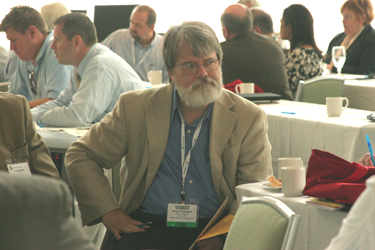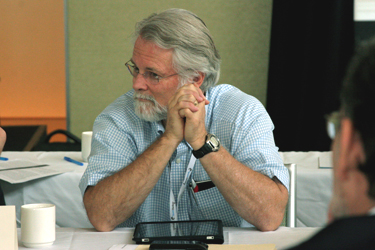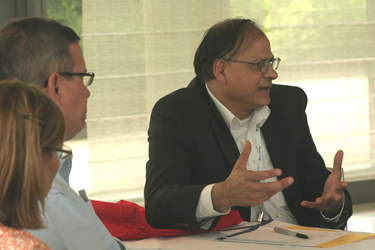Report from the Campus Technology 2010 Executive Summit
At the CT2010 Executive Summit on July 19 in Boston, discussions suggested that the trend to exclude top IT leaders from the president’s
inner strategic circle was premature and perhaps ill advised. And that CIOs who
represent their jobs as primarily or exclusively maintaining IT operations may
be missing significant national trends and changes.
As Mely Tynan, the first speaker and moderator for the day
said, “You’ve held it together, or you’d like to think so.” Tynan’s comments
opened the morning session, dedicated to a scan of the IT environment in higher
education; the afternoon would focus participants’ attention on leadership
issues.

Tynan suggested several things chief information officers
and other campus IT leaders should pay attention to--for example, the National
Science Foundation now requires a grant proposal to include a “data management
plan.” She pointed to the sharp increase in online learning enrollment and that
NGOs have begun to analyze education data and in some cases are funding transformation
with technology. These developments are important for IT leaders to pay
attention to and, to the extent that these national trends affect the
competitiveness of the institution, CIOs or key campus IT leadership should be
part of institutional strategy discussions.
Tynan also pointed to alarming statistics that should
concern technology leadership on campuses: The U.S. is only 23rd in
the world in broadband. The U.S. can boast of only a 30 percent graduation rate
after two or four years of college, which places us 15th in the
world in graduation rate. There is a U.S. Department of Education “National Technology Plan 2010," and Tynan “assigned” all those in the room to
read at least the executive summary. Another assignment: Pay attention to the New Media
Consortium’s annual Horizon Report. In it, IT leaders can see the trends in
technology--more mobility, more visualization, more immersive environments--that
can inform IT planning on campus.

At last year’s Executive Summit, a strong theme was that IT
innovation no longer originated in IT offices. Instead, innovation was
happening across campus. The meeting last year looked deeply at the end of an
era when every new technology that IT centers implemented sparked resultant
innovation in teaching, learning, and research.
In contrast, this year’s Summit pointed to hopeful signs of
new ways to structure IT leadership, not so much to spark innovation on campus
as to engage with national trends and opportunities on behalf of the
institution.
In her opening keynote, University of Southern California’s
Susan Metros challenged the participants to address the question: What does
it mean to be a literate person in today’s society? And: How can IT
leaders steer campus investment and energy to meet societal needs? How can the
institution expand global presence? And how to promote learner-centered
education? Metros suggests that certain
higher education trends are now so palpable and well-defined that IT leaders
cannot be neutral in their efforts and support whatever people ask for. Instead,
CIOs and top campus IT leaders need to pay attention to national trends in
higher education and help steer their institutions in those directions: not
iPad initiatives, but finding ways to support teaching and learning innovations
on campus that jibe with recognized national trends.

Metros pointed out that USC had identified 24 top IT
initiatives for FY11. Among these are traditional CIO concerns such as disaster
recovery, infrastructure (in their case, considering Kuali), and communication.
But others suggested a broader role for CIOs: re-considering the course
management system, for example, to see how well it is serving the changing
campus culture.
In responding to employers’ complaints that college
graduates don’t know how to collaborate, Metros suggests that IT leadership
should look at the array of collaboration tools on campus, including Google
Apps, as USC is doing. Metros lamented that the “Learning Environments” IT initiative
“had no advocate.”
But Metros focused much of her time showing specifically how
IT leaders can connect to the learning outcomes goals on campus and support
them proactively. In a key example, she mapped out the question: How can IT
initiatives match the principles of undergraduate learning at USC? She considered additional relevant questions: How
is IT leadership supporting active learning? Or intellectual breadth, depth,
and adaptability? How can IT support collaboration with other campuses?
Other speakers, Gardner Campbell of Baylor and Anne Moore of
Virginia Tech, described the poetic, manifold, ubiquitous, and rapturous
opportunities for learning and research in this age as each new technology
unfolding leads to new human awareness.
IT leaders are no longer in control of how IT plays out on
any campus, but now, like all of us, they must be attuned sufficiently to the
cultural energy and their institution’s changes and goals to steer IT support
in wise directions.
About the Author
Trent Batson is the president and CEO of AAEEBL (http://www.aaeebl.org), serving on behalf of the global electronic portfolio community. He was a tenured English professor before moving to information technology administration in the mid-1980s. Batson has been among the leaders in the field of educational technology for 25 years, the last 10 as an electronic portfolio expert and leader. He has worked at 7 universities but is now full-time president and CEO of AAEEBL. Batson’s ePortfolio: http://trentbatsoneportfolio.wordpress.com/ E-mail: [email protected]